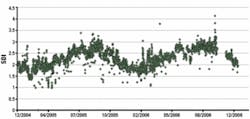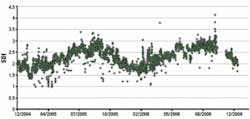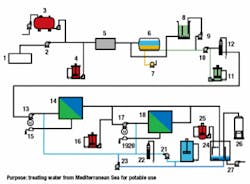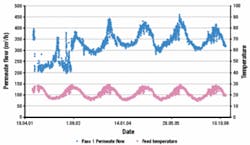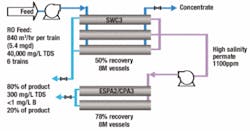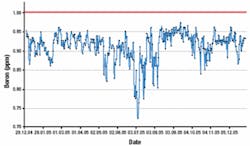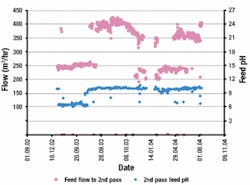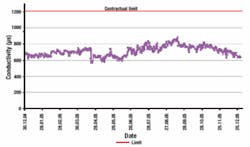Membrane Innovations: Ease Freshwater Shortages in Cyprus
Hydranautics, IDE Technologies gain long term experience with membrane performance, boron removal at the Larnaca SWRO desalination plant.
Cyprus’ shortage of freshwater was a growing problem, impeding economic development of the Mediterranean island. Despite a relative high number and adequate capacity of dams, it suffers from long drought periods. Over-abstraction of water - and thus aquifers - meant deep wells of good water quality were rapidly decreasing. As such, seawater desalination plays a vital role in the island’s potable water supply system. There are two seawater desalination plants on Cyprus. The Larnaca Seawater Reverse Osmosis (SWRO) Desalination plant is the largest and was completed in 2001 with nominal product water capacity of 54,000 m3/d. One of the 10 largest SWRO plants in Europe, it successfully meets stringent requirements of boron concentration in the product water and conforms to WHO and EU drinking standards, as well as strict energy consumption criteria. Innovative design features include split partial two-pass processing with second pass feed pH adjustment, single-stage eight-elements-per-pressure-vessel configuration and fully automated control for plant operation.
The Larnaca plant’s RO trains were initially equipped with 5,760 SWC3 membranes, made by Hydranautics. Despite technical challenges of high boron rejection requirements during commissioning and the first period of plant operation, i.e., startup and tuning, the RO system has successfully provided the requested quality and quantity of product water, with stable values of normalized flux and salt passage. Continuous efforts to improve seawater membrane performance led to development of the high temperature, high rejection membrane, the SWC4, and the high boron rejection SWC4+ membrane. These new membranes offer nominal salt rejection of 99.8% and 93% boron rejection when operated at standard test conditions with a pH of 7. At the Larnaca SWRO plant, Hydranautics elected to gradually replace some of the SWC3 elements with the new higher boron rejection membranes. Use of SWC4 elements resulted in improved economics of plant operation through reduction of second pass processing. Larnaca’s system was designed by IDE Technologies to provide reliable performance while maintaining competitive cost of product water, with dedicated monitoring of membranes and timely countermeasures applied as required. This design incorporates flexible second pass processing with pH adjustment according to feed water temperature, which could be in the range of 15-30ºC. The plant incorporates effective conventional pretreatment without use of oxidative biocide, yet still produces quality feed water that assures a low biofouling rate. During the six years of plant operation, required membrane cleanings have been relatively infrequent. Despite technical challenges of high boron rejection requirements, the plant has run successfully 100% of the time, satisfying stringent end-user water quality standards and supplying required product water flow.
Some experiments also were conducted with one train running with elevated seawater feed pH to enhance boron rejection. Results of these preliminary tests are reported here. The facility is a key reference for future development of SWRO plants in the Eastern Mediterranean as well as provides a global view of feasibility of SWRO desalination potential in potable applications.
Design History
The open intake SWRO plant was awarded in February 1999 to IDE with a build-own-operate-transfer (BOOT) contract for desalinated water by the Water Development Department of the Ministry of Agriculture, Cyprus. Construction began later that year and was completed in March 2001, with SWRO system startup in May 2001.
Unfortunately boron removal technology by membranes was new at the time and quite an uncharted area in membrane processes, thus the installation faced problems to keep these levels within contractual limits during the first period of operation. It was necessary to take immediate corrective actions and improve quality of the final product from the view of Boron amount. Hydranautics together with IDE sorted out this problem to satisfaction of local authorities with corrective actions resulting in full compliance of final product quality within contractual parameters. Since then, Hydranautics’ SWRO membranes have been producing potable water with a boron specification of less than 1 part per million (ppm). Larnaca is the largest desalination facility in Cyprus.
The plant consists of six seawater trains, each with 120 pressure vessels, featuring eight Hydranautics’ SWC3 membrane elements per vessel. The SWC3 membrane elements have 89% nominal boron rejection. After more than five years of operation, the membranes still produce the required quality and quantity of treated water. With success of each membrane desalination plant dependent largely on membrane feed water quality and pretreatment design, the Larnaca SWRO plant has pretreatment that constantly produces very good filtrate quality, despite open seawater intake and open single staged media filters. It presents an example that SWRO can work with 8m long pressure vessels successfully when membrane feed water quality is good. Figure 1 presents SDI values during last two years.
The plant employs a split partial design in which the first pass pressure vessels are constructed with two product collection points, one at the front and one to the rear. A second pass containing ESPA2 and ESPAB membranes is used to treat permeate from the rear collection port, further enhancing the final product water quality. Larnaca is the first major seawater desalinization plant to use the split partial design. A schematic of the process is shown in Figure 2.
Operational and Normalized Data
The Larnaca SWRO plant was the first major SWRO plant to have a boron specification for the product water. Using the membrane technology available at the time, SWC3 seawater element and ESPA2/CPA3 brackish elements, the operation was commenced in 2001. When the Larnaca system started operation, there were some issues with performance not matching the projected values. This was due largely to the SWC3 elements not meeting target values. A small percentage of elements were replaced to help correct the issue. For the most part, the other elements have remained in operation since that time. The plant’s replacement rate has averaged about 9%, well within expected values. And many replacements were done simply to take advantage of new higher boron rejection elements developed since project initiation.
Typical performance of a first pass train is shown in Figure 3. It demonstrates performance of the seawater elements has been quite stable. As documented in a paper presented at a 2005 International Desalination Association event in Singapore, the elements have produced the quantity and quality required for the water purchase contract. Also, pretreatment - as indicated in a 2004 IDA paper presentation - has minimized membrane fouling and ensured low maintenance and acceptable membrane life.
As described in Figure 4, the permeate from the first pass is split into low salinity permeate from the front of the vessel and high salinity permeate from the back of the vessel. The high salinity permeate is then further processed by the second pass brackish water elements. The blend is typically about 80% low salinity first pass permeate mixed with 20% of second pass permeate. This design is an efficient means to produce a low salinity permeate, which is also low in boron. Indeed, the plant has met its boron specification for product water, aside from some fine tuning in process conditions done during the first two years of operation (see Figure 5).
Furthermore, this design gives flexibility to system operation. During cold periods, the amount of water processed by the second pass can be reduced, since water quality is naturally better. This can be seen in Figure 6, where the pH was initially set around pH 7. By April 2003, the pH was then increased to 10, Improvements to the system through membrane management have allowed the plant operator to reduce the second pass pH for a good portion of the year. . The flow from the second pass varies seasonally, as mentioned. During cold months, the flow has been around 250 m3/hr, while during the warm seasons, it can be between 350 and 400 m3/hr. The former condition saving energy while the latter condition ensures boron specification is met.
Likewise, the plant has met product water TDS requirements. The contractual limit is 1,200 uS/cm. As seen in Figure 7, conductivity has always been below 800 uS/cm.
In regards to performance, it’s interesting to compare actual operation with expected operation from simulations. This is somewhat complicated for split partial systems, because not all data is available for exact comparison. An analysis is shown in Table 1. This is based on data taken on July 6, 2004. On this date, first pass trains A, B, C, E, F were in operation. Second pass trains B and C were in also operation. The flow scheme for this set of operation variables is shown in Figure 8, along with projected performance at various process steps.
From the comparison, it can be seen that pressures are within about 2-3 bar of projected pressure for the three years of operation. This is remarkably good as it indicates minimal fouling despite no cleanings being done during that time. Conductivity of train E is better than projected, train C is similar to projection, while trains A, B and F are slightly higher than projected. The blended product had an actual value of 0.94 mg/L, while the projection indicated 1.3 mg/L, indicating membrane boron rejection also is doing relatively well.
Conclusion
The Larnaca SWRO desalination plant is an example of the more complicated designs that can be used to meet stricter regulations for salinity and boron. The innovative RO process design allows the plant to run at lower operating cost and still meet the stringent product water requirements. As a result of good process engineering design, excellent pretreatment, and sound operation and management, the membranes have had good performance and expected life. The two pass design with operation of the second pass brackish system has been effective to achieve high boron rejection. The second pass has operated at pH 10 for nearly four years. The brackish membrane performance has been stable at this condition and there have been no unforeseen issues with running at this pH. This plant has verified that RO membranes can be effectively used in eight element designs, permeate from seawater vessels separated into low and high salinities, and 2nd pass RO processes running at high pH.
Authors’ Notes:
Erineos Koutsakos, MEng, MBA, Ph.D., FIChemE, is plant manager of the Larnaca Desalination Plant for IDE Technologies Ltd, Cyprus. Contact: [email protected] or www.ide-tech.com
Craig Bartels, Ph.D., Sandro Cioffi,and Stefan Rybar, Ph.D., , all work for Hydranautics - A Nitto Denko company in Oceanside, California, USA. Contact: [email protected] or www.membranes.com
Mark Wilf, Ph.D., is membrane technology director for Tetra Tech based in Irvine California, USA.
The above article is based on a paper submitted for the European Desalination Society’s Conference on Desalination and the Environment in Halkidiki, Greece, in April 2007.
